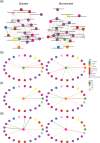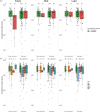Secretor status is a modifier of vaginal microbiota-associated preterm birth risk
- PMID: 39630497
- PMCID: PMC11616779
- DOI: 10.1099/mgen.0.001323
Secretor status is a modifier of vaginal microbiota-associated preterm birth risk
Abstract
Mutations in the FUT2 gene that result in a lack of expression of histo-blood group antigens on secreted glycoproteins may shape the vaginal microbiota with consequences for birth outcome. To test this, we analysed the relationship between secretor status, vaginal microbiota and gestational length in an ethnically diverse cohort of 302 pregnant women, including 82 who delivered preterm. Lactobacillus gasseri and L. jensenii were found to have distinct co-occurrence patterns with other microbial taxa in non-secretors. Moreover, non-secretors with Lactobacillus spp. depleted high diversity vaginal microbiota in early pregnancy had significantly shorter gestational length than Lactobacillus spp. dominated non-secretors (mean of 241.54 days (sd=47.14) versus 266.21 (23.61); P-value=0.0251). Similar gestational length differences were observed between non-secretors with high vaginal diversity and secretors with Lactobacillus spp. dominance (mean of 262.52 days (SD=27.73); p-value=0.0439) or depletion (mean of 266.05 days (SD=20.81); p-value=0.0312). Our data highlight secretor status and blood-group antigen expression as being important mediators of vaginal microbiota-host interactions in the context of preterm birth risk.
Keywords: Lactobacillus; blood-type antigens; preterm birth; secretor status; vaginal microbiome.
Conflict of interest statement
P.R.B. and D.A.M. have a patent for the use of
Figures



References
-
- Audfray A, Varrot A, Imberty A. Bacteria love our sugars: interaction between soluble lectins and human fucosylated glycans, structures, thermodynamics and design of competing glycocompounds. Comptes Rendus Chimie. 2013;16:482–490. doi: 10.1016/j.crci.2012.11.021. - DOI
MeSH terms
Substances
Supplementary concepts
LinkOut - more resources
Full Text Sources
Miscellaneous

